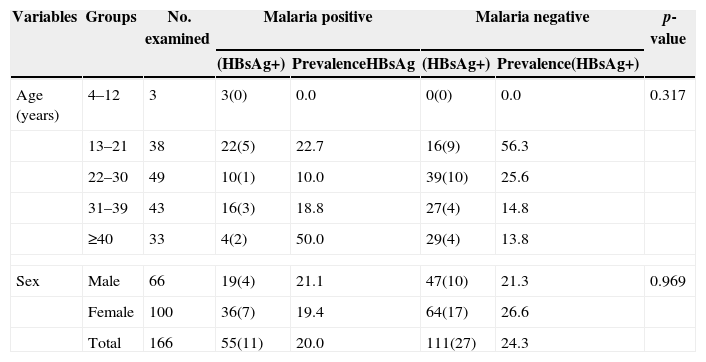Infection due to Plasmodium falciparum is a serious public health threat in sub-Saharan Africa. Malaria endemic foci are often times affected by other infectious agents which may contribute to the clinical episodes of the disease.1 Hepatitis B virus is one of such infectious agents that coexist with P. falciparum in most endemic areas. Although the accurate infection status due to hepatitis B virus infection is not yet known, an estimated 350 million persons worldwide are chronic carriers.2,3 Since both infectious agents make use of host liver cells for intracellular multiplication, parasites induced direct or immunologically mediated interactions in concurrent infections could potentially escalate or inhibit progression of both infections.4 While there are several epidemiological studies on malaria parasites and hepatitis B virus single infection in Nigeria and other parts of sub-Saharan Africa, very few focused on concomitant occurrence of these two pathogens. There is a need to gather more epidemiological data on their concurrent existence to determine the possible associations between these infectious agents. Thus, this study determined the coexistence of P. falciparum and hepatitis B virus among regular attendees of Queen's Clinic, a private hospital located in Abuja, Nigeria.
The cross-sectional study was conducted from May to August 2014 in individuals aged 4–73 years. The subjects included those who visited the hospital for medical consultation. Blood sample collected by venipuncture was smeared into thin and thick films, air dried and stained with field's stain A and B and then examined for presence of malaria parasites. Hepatitis B virus was diagnosed using rapid serological kit according to manufacturer's instructions. The study was approved by the Babcock University Ethical Review Committee, Ogun State, Nigeria. The analysis of the data was performed by GraphPad Prism, version 5. The differences in proportion of single and co-infection status were tested by Chi-square test. Multivariate logistic regression analysis was used to determine the extent of the association between age, sex, and disease occurrence.
A total of 166 subjects were recruited in the study. Only P. falciparum was diagnosed in the subjects. The prevalence of P. falciparum, hepatitis B virus, and co-infection of the two pathogens was 33.1%, 22.9%, and 6.6% respectively. While the prevalence of malaria was age dependent (p<0.0001), hepatitis B virus infection and co-infection of the two pathogens was neither age nor sex dependent (p>0.05) (Table 1). The prevalence of hepatitis B virus in P. falciparum infected and non-infected individuals was 20.0% and 24.3% respectively. This study shows the persistence of malaria and hepatitis B virus in Nigerian urban centres. More rational methods towards the control of these diseases are advocated. While integrated control measures targeted at various stages are suggested for malaria, wider hepatitis B virus vaccination programme coverage is warranted. Co-infection of the two pathogens suggests a negative interaction but more prospective studies with larger sample size and consideration of immune interplay is recommended.
Associations between malaria parasites and hepatitis B virus.
| Variables | Groups | No. examined | Malaria positive | Malaria negative | p-value | ||
|---|---|---|---|---|---|---|---|
| (HBsAg+) | PrevalenceHBsAg | (HBsAg+) | Prevalence(HBsAg+) | ||||
| Age (years) | 4–12 | 3 | 3(0) | 0.0 | 0(0) | 0.0 | 0.317 |
| 13–21 | 38 | 22(5) | 22.7 | 16(9) | 56.3 | ||
| 22–30 | 49 | 10(1) | 10.0 | 39(10) | 25.6 | ||
| 31–39 | 43 | 16(3) | 18.8 | 27(4) | 14.8 | ||
| ≥40 | 33 | 4(2) | 50.0 | 29(4) | 13.8 | ||
| Sex | Male | 66 | 19(4) | 21.1 | 47(10) | 21.3 | 0.969 |
| Female | 100 | 36(7) | 19.4 | 64(17) | 26.6 | ||
| Total | 166 | 55(11) | 20.0 | 111(27) | 24.3 | ||
None.
ContributorsOTO conceived, designed, analysed data, and drafted the manuscript. ANA gathered the data and performed laboratory procedures. All authors approved the final version of the manuscript.
Conflicts of interestThe authors declare no conflicts of interest.





